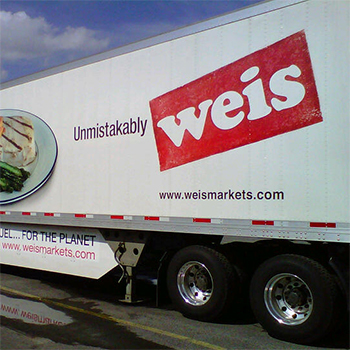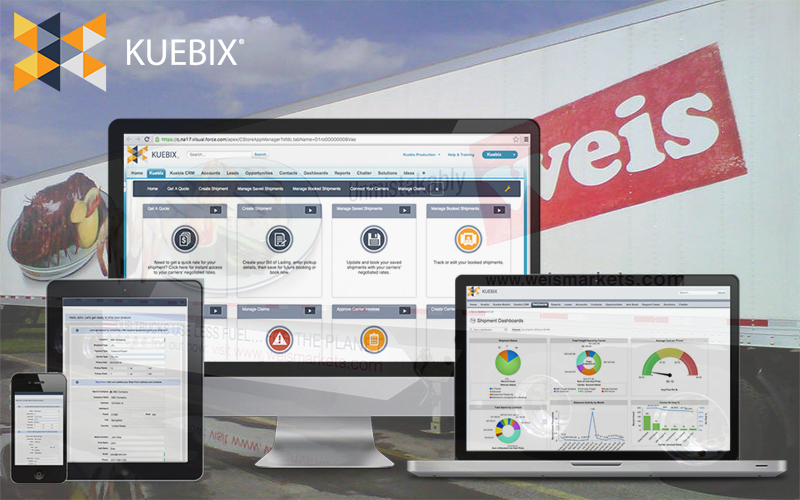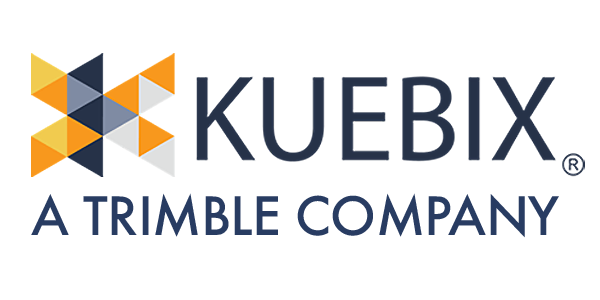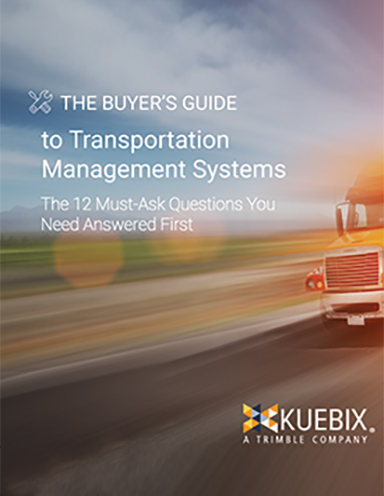Streamlining Inbound & Outbound Freight Activities with a Cloud Transportation Management System

Weis Markets with 200+ locations, this 105-year-old food retailer is leveraging a Kuebix Cloud transportation management system to streamline inbound and outbound freight activities at its 1.3-million-square-foot distribution center in Central Pennsylvania.
Since 2015, Weis Markets has achieved record growth, and barely resembles the single neighborhood store that Harry and Sigmund Weis opened in Sunbury, Pa. in 1912.
As such, its TMS had to effectively scale up to meet the grocery retailer’s needs - a priority Gary Kinneer, the company’s director of managed transportation, says was near the top of the firm’s “must-have” list as it shopped for a solution in 2014.
“In order to truly maximize our DC efficiencies, we needed to have a better handle on the data,” said Kinneer.
“We needed a transportation management system to access the data and make better, more informed decisions. Quite simply, we needed a solution.”
With locations in Pennsylvania, Maryland, New York, New Jersey, Delaware, Virginia and West Virginia, Weis Markets has more than 23,000 associates, processes its own milk and ice cream and has a strong focus on buying local.
In its home state of Pennsylvania, the company purchases more than 26 million pounds of locally-grown produce annually.
As a vertically integrated food retailer, the company supplies its stores from a 1.3-million-square-foot distribution center (DC) in Milton, Pa. Located about 12 miles from its Sunbury store support center and manufacturing facilities, this facility manages all of the firm’s product distribution (excluding its direct store delivery or “DSD”).
“Nearly everything we sell runs through our distribution center,” says Kinneer.
Operating 365 days a year, Weis Markets’ DC serves as a critical link between the company and its end users who shop in the retailer’s 204 stores. The company has its own fleet of tractor-trailers and other vehicles that it uses to service those stores.
“Our trucks travel about 270,000 miles a week and ship about 1,000 loads to our stores,” says Kinneer, noting that on the distribution side alone Weis Markets has about 900 associates (700 DC employees and 200 drivers).
Weis Markets is not in the business of “storing things for a long period of time,” Kinneer notes. Over a week, it receives approximately 1,000 inbound loads - 2 million cases across 25,000 SKUs.
“That’s what we do in Milton, Pa.,” says Kinneer, “day in and day out.”
Streamlining Both Sides of the Distribution Center Door
In 2014, Weis Markets started looking for a way to gain efficiencies in its operations and improve oversight and visibility of its inbound freight logistics. “We didn’t have a transportation management system (TMS), and we needed to improve our efficiency at the DC level,” says Kinneer.
“Our goal was to find a better inbound-outbound balance that would allow us to achieve a more streamlined distribution operation.”
Kinneer, who spent most of his earlier career on the store operations side of the business, was asked to head up the TMS search and oversee its implementation. And while he wasn’t working within the supply chain when the initial decisions were made, he says the TMS initiative was actually spurred on by the need to improve distribution efficiencies.
“There wasn’t any specific ‘tipping point’ that pushed the initiative through,” says Kinneer. “But it was clear we needed to do a better job maximizing our opportunities.” The company had 166 locations at the time and was anticipating solid organic (building new stores) growth supplemented by an occasional acquisition (buying existing stores).
“We knew that in order to absorb that growth - and the inbound and outbound volume associated with it,” he says, “we had to become more efficient at the DC level.”
To kick off its search for a TMS, Weis Markets considered the various brand name options on the market. The company sought out a vendor that would provide the technology, the data, and the expertise “behind the technology,” says Kinneer.
“Organizationally, we needed a TMS solution provider that not only had the technology, but that also could provide us with support services to initiate those processes here at Weis Markets,” says Kinneer. “We needed a partner to help us build our managed transportation program.”
The retailer found what it was looking for in Kuebix TMS, a Cloud-based transportation management system that incorporated all of its “must haves.”
“Kuebix aligned with what we envisioned as our business model,” says Kinneer, whose team utilizes the TMS in several ways, including for inbound compliance and routing.
“We developed an inbound compliance and routing guide that established standards, parameters, and consistency across our vendors and carriers,” he says.
Since it rolled out this portion of the program, Weis Markets has improved utilization of its 1.3 million square foot warehouse, which includes grocery, non-food and temperature-controlled space.
“The inbound compliance not only gave us the consistency of expectations of what was coming in from the outside, but it also provided some consistency for internal activities and allowed us to streamline efficiencies on both sides of the door.”
Tracking Down the Data
Using its TMS, Weis Markets can now better leverage less-than-truckload (LTL) consolidation by partnering with three select national LTL carriers, versus the dozens of options that it was previously using.
So, where carriers were previously delivering “one or two pallets here and there” to the DC, Kinneer says that those are now all delivered to consolidation points. Using its own fleet, Weis Markets then backhauls from those points and into its own DC.
“In the past, we had a couple of hundred LTL deliveries coming in per week,” says Kinneer, “and now we’re down to just 20 or 30 because we can use our TMS to combine the LTL deliveries from the consolidation points.”
In another win, Weis Markets is using its TMS for online scheduling - a process that it previously handled manually. Using its own parameters, standards, data points and expectations, the retailer can now give its suppliers specific delivery time frames via Kuebix’s Cloud-based, interconnected solution.
“This has not only streamlined the scheduling process, but it has also given us a tremendous amount of tracking information and data that we didn’t have before.”
Read: Why is Big Data, and Managing it, Such a Big Deal?
Don’t Be Afraid To Evolve
Rewind just three years and Weis Markets was using its own fleet to make deliveries to stores and then manually ferreting out backhaul opportunities with DCs or manufacturing facilities near those stores.
Today, with increased access to data, Weis Markets had not only dramatically expanded its backhaul program from within its marketplace but has also engaged in the conversion of vendor delivered lanes to customer pick up from across the country.
Once picked up, those loads are brought back to the firm’s Milton DC. Weis Markets is then reimbursed by its own vendors, which didn’t have to hire third-party carriers to do the work, making the overall process mutually beneficial for both parties.
“It’s a win-win for their respective businesses,” says Kinneer. “Vendors reduce their costs, and they’re no longer in the transportation business. At the same time, we’re increasing revenue or reducing our cost of goods.”
Thanks to its TMS, the retailer can now better leverage this opportunity. “We have much better insights into the value of lane rates and the value of pickups,” Kinneer explains. “It really allowed us to make better-informed decisions as to what freight transportation we’re managing.”
To shippers that are considering a Cloud TMS upgrade - or a completely new system - Kinneer says that the first step should be to consider all of the options currently available on the market. Come up with a list of must-haves for the system, and then find the platform that best meets your own organizational needs.
And don’t forget to factor the future into the equation, knowing that the company you’re running today may look very different just three to five years down the road.
“It’s only been about three years, but our relationship with Kuebix has evolved during a period of record growth for our company,” says Kinneer.
“How we envisioned it back in early 2015 is not necessarily how it looks today. And that’s a good thing because it means we’ve all evolved.”
Related Article: Integrating Transportation Management Systems Functionality via API Technology
White Paper
Effectively Managing Big Data in Your Supply Chain
In this white paper, we’ll explain what the term “big data” means to the typical supply chain, introduce effective strategies for managing and leveraging that data, show how one grocer is using predictive analytics to harness its own big data, and explain the “first steps” that companies need to take down the path to effective management of their big data. Download Now!
Get started today with your FREE TMS Trial!

Article Topics
Kuebix News & Resources
Visibility + TMS = A Winning Combination Trimble Placed in 2021 Gartner Magic Quadrant for Real-Time Transportation Visibility Platforms Kuebix Positioned Again as a Challenger in 2021 Gartner Magic Quadrant for TMS The Buyer’s Guide to Transportation Management Systems TMS Update: Adoption accelerates The Logistics of Valentine’s Day during COVID-19 Pandemic Research: Trends in the Supply Chain and Their Impact on the Transportation Management System Market More KuebixLatest in Transportation
Ask an Expert: How Shippers Can Prep for Hurricane Season UPS Struggles in First Quarter With Steep Earnings Decline FedEx Announces Plans to Shut Down Four Facilities The Two Most Important Factors in Last-Mile Delivery Most Companies Unprepared For Supply Chain Emergency Baltimore Bridge Collapse: Impact on Freight Navigating Amazon Logistics’ Growth Shakes Up Shipping Industry in 2023 More TransportationAbout the Author


















